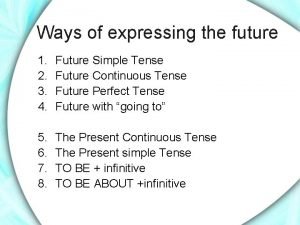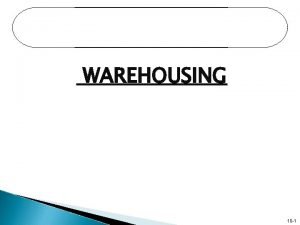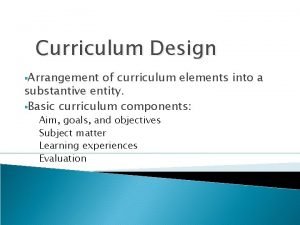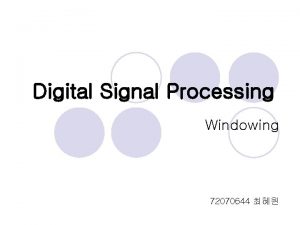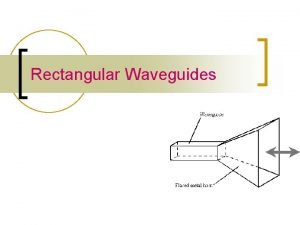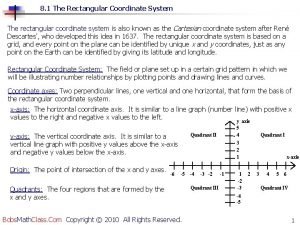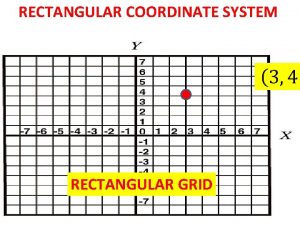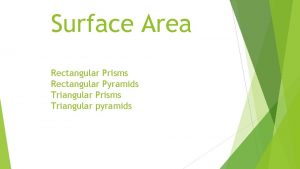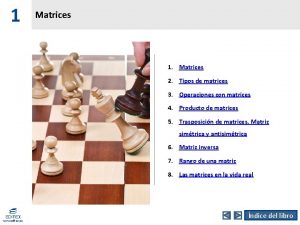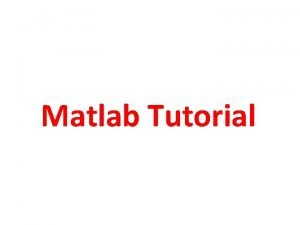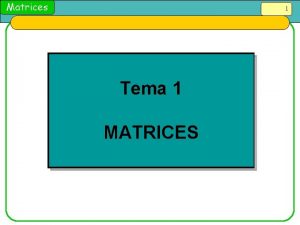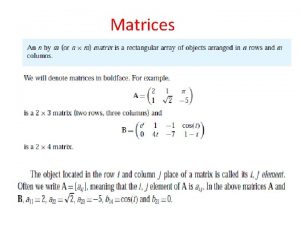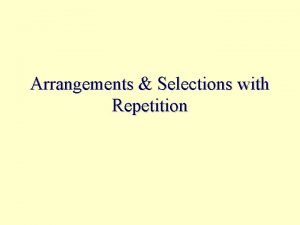4 6 Matrices 1 Matrices are rectangular arrangements


















- Slides: 18

4. 6 Matrices 1

Matrices are rectangular arrangements of data that are used to represent information in tabular form. a 23 Dimensions: number of rows and columns A is a 2 x 3 matrix Elements of a matrix A are denoted by aij. a 23 = 8 2

Data about many kinds of problems can often be represented by matrix. e. g Average temperatures in 3 different cities for each month: 3 cities 12 months Jan - Dec Average temp. in the 3 rd city in July, a 37, is 91. 3

Matrix of coefficients Solutions to many problems can be obtained by solving systems of linear equations. For example, the constraints of a problem are represented by the system of linear equations x + y = 70 24 x + 14 y = 1180 is the matrix of coefficient for this system of linear equations. 4

In a matrix, the arrangement of the entries is significant. Therefore, for two matrices to be equal they must have the same dimensions and the same entries in each location. Example: Let If X = Y, then x = 3, y = 6, z = 2, and w = 0. 5

Square Matrix is a matrix in which the number of rows equals the number of columns. • Main Diagonal: in a n x n square matrix, the elements a 11, a 22, a 33, …, ann form the main diagonal of the matrix. • Symmetric matrix: If the corresponding elements match when we think of folding the matrix along the main diagonal, then the matrix is symmetric about the main diagonal. In a symmetric matrix, aij = aji. 6

Example: The square matrix Main Diagonal is symmetric. Note that a 21 = a 12 = 5 a 31 = a 13 = 7 a 32 = a 23 = 2 7

Matrix Operations 1. Scalar multiplication: 2. Multiply each entry of a matrix by a fixed single number called scalar. 3. ex: The result of multiplying matrix 4. by the scalar r = 3 is 8

2. Addition: 3. Adding the corresponding elements of 2 matrices that have the same dimensions. 4. ex: For 5. the matrix A+B is 9

3. Subtraction: 4. defined by A – B = A + (-1)B. 5. 6. 7. In a zero matrix, all entries are 0. An n m zero matrix is denoted by 0. If A and B are n x m matrices and r and s are scalars, the following matrix equations are true: 8. 0+A=A 9. A+B=B+A 10. (A + B) + C = A + (B + C) 11. r(A + B) = r. A + r. B 12. (r + s)A = r. A + s. A 13. r(s. A) = (rs)A 10

4. Multiplication of matrices: 5. 6. 7. 8. 9. 10. 11. A: B: n m matrix The result C is an n p matrix. m p matrix A B = C, where An entry in row i, column j of A B is obtained by multiplying elements in row i of A by the corresponding elements in column j of B and adding the results. To compute A times B, the number of columns in A must equal the number of rows in B. 11

Example: Let 2 3 matrix 3 2 matrix 2(5) + 4(2) + 3(6) = 10 + 8 + 18 = 36 Note that A is a 2 3 matrix and B is a 3 2 matrix. The product A • B is a 2 2 matrix. 12

Example: Compute A B and B A for Note: A B B A. 13

Where A, B and C are matrices of appropriate dimensions and r and s are scalars, the following matrix equations are true: (The notation A(B C) is shorthand for A (B C) ) A(B C) = (A B)C A(B + C) = A B + A C (A + B)C = A C + B C r. A s. B = (rs)(A B) 14

Identity matrix The n n matrix with 1 s along the main diagonal and 0 s elsewhere is called the identity matrix, denoted by I. If we multiply I times any n n matrix A, we get A as the result. The equation I • A=A • I=A holds. Let Similarly, A • I=A. 15

An n n matrix A is invertible if there exists an n n matrix B such that A • B=B • A=I In this case B is called the inverse of A, denoted by A-1. Let Then, following the rules of matrix multiplication, it can be shown that A • B = B • A = I, so B = A-1. 16

Boolean Matrices with only 0 s and 1 s as entries are called Boolean matrices. Boolean multiplication: x y = min(x, y) Boolean addition: x y = max(x, y) Boolean matrix multiplication A B is defined by m Cij = (aik bkj) k=1 A B: corresponding elements are combined using Boolean multiplication. A B: corresponding elements are combined using Boolean addition. 17

Let A and B be Boolean matrices, Then And the Boolean product A B is 18
 Antigentest åre
Antigentest åre Access arrangements training
Access arrangements training Sahar mahdi
Sahar mahdi Chapter 2 history of floral design answer key
Chapter 2 history of floral design answer key What is seating arrangement in classroom
What is seating arrangement in classroom Assessment and reporting arrangements 2017
Assessment and reporting arrangements 2017 Different ways of expressing future
Different ways of expressing future Gcf of 64
Gcf of 64 Classical revival floral design
Classical revival floral design Egyptian period floral design
Egyptian period floral design Line arrangements
Line arrangements Objectives of foreign collaboration
Objectives of foreign collaboration Permutasi string
Permutasi string What is spot stocking
What is spot stocking Elements of a curriculum
Elements of a curriculum Con 100 shaping smart business arrangements
Con 100 shaping smart business arrangements Arrangement of the story called
Arrangement of the story called Egyptian flower arrangements
Egyptian flower arrangements Present continuous plan
Present continuous plan






